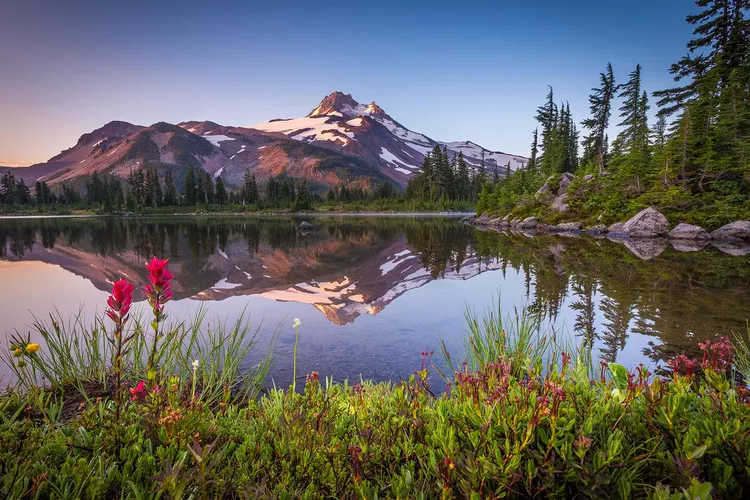Summary
There’s a lot to explore in more than 1.6 million acres of Oregon forestland.
The Willamette National Forest is expansive, encompassing eight wilderness areas and seven major volcanic peaks across more than 1.6 million acres of preserved wildlands. This wilderness rivals all others, with near-untouched terrain that can be explored by bike, boat, car, or foot. Moreover, while the landscape is wild, featuring old-growth forests, high mountain lakes, and jagged peaks, it remains surprisingly accessible — just 30 minutes east of Eugene, Oregon, and under two hours south of Portland, Oregon.
The year-round adventure destination in the heart of Oregon offers activities for everyone. In summer, enjoy hiking, biking, rafting, and fishing. In winter, the activities shift to skiing, snowmobiling, and dog sledding. Enjoy camping year-round, embark on scenic drives through the wild landscape, or experience the majestic volcanic peaks rising above the hills and rivers: Mount Jefferson, Three Fingered Jack, Mount Washington, Diamond Peak, and the Three Sisters.
Scenic Drives in Willamette National Forest
Willamette National Forest has more than its fair share of scenic roads, including the West Cascades Scenic Byway. This byway skirts the northern half of the Cascade Mountains, offering plenty of pull-off points with views of alpine lakes, towering waterfalls, and dense, ancient forests. If navigating the full 222-mile route feels daunting, rest assured you can camp, hike, and bike along the way.

Another popular drive is the McKenzie Pass-Santiam Pass Scenic Byway, an 82-mile loop around two mountain passes. This route offers plenty of spots to stop, stretch your legs, or cast a line. Additionally, along the loop, you’ll witness old-growth Douglas fir and red cedar forests, lava fields, crystal-clear mountain lakes, waterfalls, and stunning volcanoes with glaciers.
Hiking and Biking Adventures
As you might expect from a forest this size, Willamette National Forest boasts over 1,700 miles of trails. There are single-track routes for bikers, horseback riding trails, and both heavily trodden and rarely used hiking paths that crisscross the protected forestland.
If you’re searching for wildflowers, check out the Iron Mountain Trail, home to more than 300 species of flowering plants, ending at barren volcanic rock. Meanwhile, mountain views are abundant in the Willamette Pass Trail Area, which features paths suited for hikers, bikers, and horses, including the scenic Diamond Creek Falls Trail, Salt Creek Falls Trail, and Vivian Lake Trail.

For water access, head to the McKenzie River Ranger District and hike the Waterfalls Loop Trail to see the stunning Sahalie and Koosah Falls of Oregon.
Camping Opportunities
Camping options within Willamette National Forest are abundant. There are more than 70 developed campgrounds equipped with amenities like fire pits, toilets, RV hookups, and water, plus numerous primitive or dispersed campsites where you may not encounter another tent for miles.
The Sweet Home Ranger District is central to the national forest and one of the area’s most popular summer camping spots. Within Sweet Home, you’ll find House Rock Campground, located in an old-growth forest near a river confluence. Many campsites are positioned along the river, and hiking trails originate directly from the campground. Nearby, the Trout Creek Campground features a similar ambiance, providing access to the Menagerie Wilderness, popular among hikers and backpackers.

Camping is also great around Detroit Lake, southeast of Salem, Oregon. Five campgrounds surround the lake, known for its trout fishing, including a boat-accessible campsite on Piety Island. To the south, Waldo Lake offers lakefront camping with sandy shores, especially at Islet Campground, which provides excellent beach access, a boat launch, and ample hiking trails.
Best Times to Visit
Willamette National Forest is accessible year-round — even in winter. During the cool winter months, head to Santiam Pass for cross-country skiing, snowmobiling, sledding, and dog sledding. If you’re feeling adventurous, check out Hoodoo Ski Area for downhill skiing and snowboarding. Willamette Pass also serves as a winter destination, offering downhill boarding at Willamette Pass Resort along with great opportunities for cross-country skiing, snowmobiling, and sledding.
In late spring and summer, the national forest opens fully, inviting visitors who wish to see the vibrant wildflowers and indulge in freshly picked huckleberries. As the weather cools, crowds diminish, providing hikers with wide-open trails and clear autumn days.





